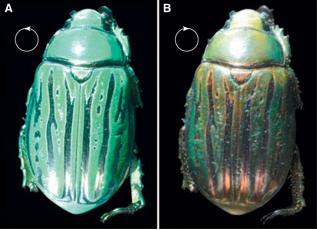
A structure much like a liquid crystal allows the shell of a scarab beetle to circularly polarize light, scientists in the US have discovered.
Mohan Srinivasarao of the Georgia Institute of Technology and colleagues have used microscopy techniques to show that the iridescent green scarab beetle (Plusiotis gloriosa), has a shell that contains a helical structure, rather like a “cholesteric” liquid crystal.
“This study is important because it highlights how animals produce very complex nanostructures by self-assembly,” Srinivasarao told physicsworld.com. “The resulting structures are optically active and produce brilliant metallic green structures, [and] the optical activity results in reflected light being circularly polarized.”
Ripe for bio-mimicry?
There are many examples of insect shells, fish scales, bird feathers and other objects in the animal kingdom that have unusual optical properties. Sometimes researchers find the properties surpass those in manmade materials, in which case they can try to copy the animal’s design. In 2007, researchers discovered that a tropical beetle’s oddly bright white shell was the result of an “aperiodic” shell structure, and said it could lead to a new type of super-white, synthetic material.
Using reflected-light microscopy, Srinivasarao’s group could see how the shell of Plusiotis gloriosa changes colour at different angles, producing the iridescent colours visible to the human eye. However, using laser-scanning confocal microscopy for higher magnifications, the group could discern a helical structure. This structure resembled a cholesteric liquid crystal, which circularly polarizes light as a result of defects that twist its ordered layers of molecules with respect to one another.
Srinivasarao thinks the scarab beetle’s shell could, like other animals, be mimicked for manmade applications. “One could envision making very shiny metallic colours by taking a cholesteric fluid and varying the conditions at which the surface defects appear,” he says.
Unknown use
Biophysicists are just beginning to realize that animals can make use of circularly polarized light. Last year, researchers in Germany and Australia suggested that the “mantis shrimp” uses circular polarization for enhanced communication. However, it is not yet clear whether this scarab beetle employs the optical effect for the same purpose.
“The purpose of the shell is still under some debate,” says Srinivasarao. “Mainly it is supposed to be for mating purposes, [but] the full range of purpose is not yet known…currently there is no evidence that Plusiotis gloriosa can actually distinguish circularly polarized lights of different handedness.”
Srinivasarao adds that he and his colleagues are now investigating why the beetle evolved the polarizing property.
This research appears in the latest edition of Science.



